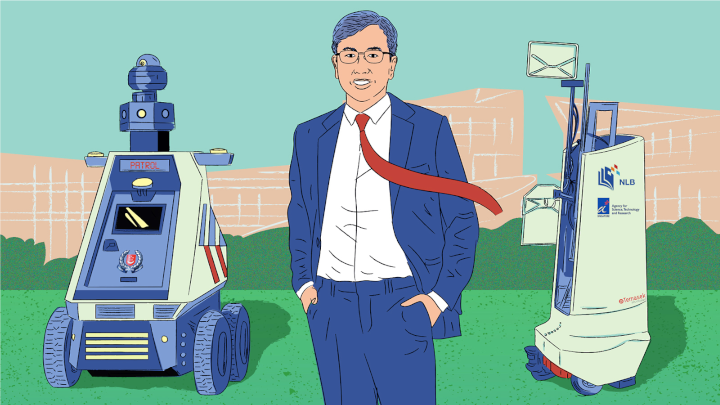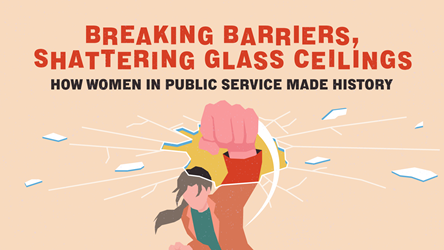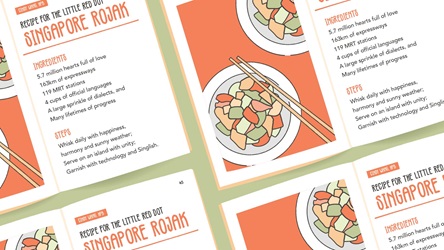I, Partner – A*STAR’s Technologies In The Public Service

From the cyborg assassins in the Terminator movie series to the endearing humanoid C-3P0 in the space opera franchise Star Wars, popular representations of robots often imbue them with intelligence that mirrors or supplants that of humans.
The reality for now and the near future, at least, is far different. Robots, while becoming increasingly sophisticated, are nowhere near gaining the kind of autonomy they have in science fiction movies.
In the field of robotics and artificial intelligence, A*STAR Chief Executive Officer Frederick Chew sees, instead, a “man-machine partnership environment” arising from robot-assisted work.
“I don’t believe that robots will replace humans fully, at least not in the next 50 years.”
That does not mean that he discounts advancements in robotics. As he says: “Robots today are getting very smart and capable.” Over the years, a focus of A*STAR’s work has been on applying robotics intelligence to everyday operations in the Public Service.
Besides robotics, A*STAR is active in other fields such as 3-D modelling for urban development. Computer simulations can help urban planners account for environmental effects on buildings.
Strengthening partnerships
For all of these technologies to flourish, another partnership is crucial: the one between public agencies. Mr Chew, who concurrently holds the title of Chief, Public Sector Science & Technology Policy and Plans Office, is working with government agencies to strengthen science and technology (S&T) across the public sector.
To achieve this, he encourages public agencies to engage in long-term collaborations with A*STAR to deepen their S&T capabilities, so that the technologies can be better translated to improve the lives of Singaporeans.
“Traditionally, agencies encountering a problem would see if the institutes of higher learning (IHLs) or A*STAR could solve it – a somewhat one-off approach,” says Mr Chew.
What is needed, he adds, is a better match between the supply of technologies coming from the IHLs or A*STAR, and the demand or needs of the public agencies.
“This requires design thinking to permeate into our traditional ‘research to innovation to enterprise’ constructs, particularly for the technology suppliers to begin with the end in mind – the end being to solve national challenges and to impact our citizens, society and economy,” says Mr Chew.
Mr Chew has charged A*STAR’s scientists with this same mission. A*STAR’s scientists are increasingly working more closely with public officers from different organisations to come up with technological solutions that meet specific operational needs.
Here are three projects where A*STAR’s technologies have brought people, robots and computer simulations together to enhance the way people live and work.
Urban cooling
In construction, by the time the scaffolding is raised and concrete is poured, it is too late to make any drastic changes to adapt a building to its environmental conditions.
To avert such a scenario, A*STAR worked with the Housing Development Board (HDB) to create the Integrated Environmental Modeller (IEM) for urban planning. It was adopted in the planning of the new Tengah town to build a comfortable living environment.
Through this technology, urban planners can simulate the effects of environmental factors on urban developments, such as solar heat, wind flow and air temperature. Based on this information, open spaces and building layouts can be designed and oriented such that wind flows provide natural ventilation within Tengah.
The team behind the IEM, led by senior scientist Poh Hee Joo from A*STAR, was awarded the prestigious President’s Technology Award in October 2019.

Robot eyes on patrol
The Multi-purpose All Terrain Autonomous Robot (MATAR), as its abbreviated name suggests, was designed to help the police (mata-mata in colloquial Malay) in their patrolling duties.
Jointly developed by A*STAR and the Ministry of Home Affairs’ Home Team Science and Technology Agency (HTX), this robot has drawn the public’s attention since it was first unveiled at the Singapore Police Force’s Workplan Seminar in 2018.
The latest version of the patrol robot, MATAR 3.0, is equipped with 360-degree coverage of both sound and visual sensors, with onboard machine intelligence to recognise anomalies. It can navigate autonomously with 3D mapping and localisation capabilities, and comes with a tethered unmanned aerial vehicle (UAV) that can rise to 30 metres for aerial surveillance.
It is currently being tested to improve its effectiveness in enhancing patrolling routines and officers’ monitoring of crowds.
Shelf-aware
The Autonomous Library Shelf Scanning (Aurora) robot goes on patrols, too – but its mission is to spot errant library books rather than criminals.
Aurora was developed in response to the National Library Board’s desire to improve its shelf-reading process. Using radio frequency identification tags and laser mapping technology, Aurora can scan shelves with 99% accuracy, lightening the load of support librarians, volunteers and interns.
Together, the NLB and A*STAR ran a pilot programme with the robot at Pasir Ris Public Library in 2015. The NLB now deploys Aurora in six public libraries.
During this period, work processes were developed to ensure a “smooth human-robot collaboration”, says Mr Peter Mao, Chief Executive Officer of Senserbot, which worked on the pilot and has since spun off from A*STAR to launch as a commercial entity.
“For example, the robots will pass the data obtained in nightly scans to the librarians in the morning,” he explains. “Then the librarians will work on the results to accelerate the shelf-reading process.”
Previously, librarians had to manually inspect the shelves and look out for books placed in the wrong categories – not to mention those that are deliberately hidden by visitors who want sole access to certain titles.
Now, librarians can get right to shelving the books. With a lightened workload, they can also focus on more pressing customer services.
Library users can heave a sigh of relief knowing that this robot is not equipped with forensic capabilities to track the source of misplaced books.
The takeaway
- Rather than robots taking over humanity, people and robots will work together in robot-assisted work.
- Combined technologies can be used to help public officers such as urban planners make better decisions to improve Singaporean’s way of life.
- Partnerships between public agencies and strengthening capabilities are key for boosting innovation across the Public Service.
- POSTED ON
Jan 30, 2020
- TEXT BY
Simon Vincent
- ILLUSTRATION BY
Mushroomhead









